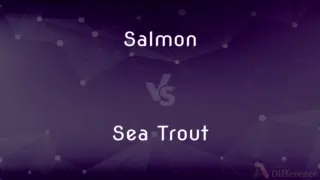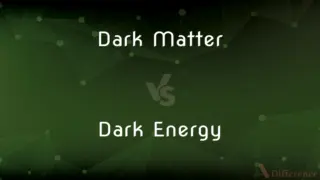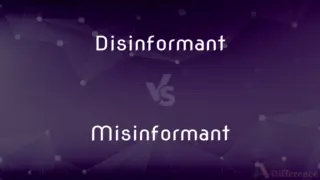Bacteriocin vs. Antibiotic — What's the Difference?
Edited by Tayyaba Rehman — By Maham Liaqat — Updated on May 19, 2024
Bacteriocins are protein-based toxins produced by bacteria to inhibit the growth of similar or closely related bacterial strains, while antibiotics are chemical substances, either natural or synthetic, that can kill or inhibit a wide range of bacteria.

Difference Between Bacteriocin and Antibiotic
Table of Contents
ADVERTISEMENT
Key Differences
Bacteriocins are antimicrobial peptides produced by bacteria to target and inhibit the growth of closely related bacterial strains. They are usually narrow-spectrum, meaning they are effective against specific types of bacteria. Antibiotics, on the other hand, are substances, either produced naturally by microorganisms or synthesized chemically, that can kill or inhibit a broad spectrum of bacteria. Antibiotics can target a wide range of bacteria, including both gram-positive and gram-negative types.
While bacteriocins are typically specific to the producing bacterial species and their close relatives, antibiotics have a broader target range, making them versatile in treating various bacterial infections. Bacteriocins tend to be less likely to cause resistance in non-target bacteria because of their specificity, whereas the widespread use of antibiotics has led to significant issues with antibiotic resistance.
Bacteriocins are primarily of interest in food preservation and as potential alternatives to antibiotics in medical applications due to their specificity and lower likelihood of resistance. Antibiotics remain the mainstay of bacterial infection treatment but face challenges due to the growing problem of antibiotic-resistant bacteria.
Comparison Chart
Definition
Protein-based toxins produced by bacteria
Chemical substances that kill/inhibit bacteria
Spectrum of Activity
Narrow, targeting specific bacteria
Broad, targeting a wide range of bacteria
ADVERTISEMENT
Source
Produced by bacteria
Natural or synthetic origins
Application
Food preservation, potential medical use
Treating bacterial infections
Resistance
Lower likelihood of resistance
Higher likelihood of resistance
Compare with Definitions
Bacteriocin
Protein-based antimicrobial substances produced by bacteria.
Lactococcus lactis produces the bacteriocin nisin.
Antibiotic
Can be natural or synthetic.
Many antibiotics are derived from molds, while others are synthesized in labs.
Bacteriocin
Inhibits growth of closely related bacterial strains.
Bacteriocins help bacteria outcompete other strains in the same environment.
Antibiotic
An antibiotic is a type of antimicrobial substance active against bacteria. It is the most important type of antibacterial agent for fighting bacterial infections, and antibiotic medications are widely used in the treatment and prevention of such infections.
Bacteriocin
Often used in food preservation.
Nisin, a bacteriocin, is used to prevent spoilage in dairy products.
Antibiotic
A substance, such as penicillin or erythromycin, produced by or derived from certain microorganisms, including fungi and bacteria, that can destroy or inhibit the growth of other microorganisms, especially bacteria. Antibiotics are widely used in the prevention and treatment of infectious diseases.
Bacteriocin
Potential alternative to antibiotics.
Researchers are exploring bacteriocins as new treatments for bacterial infections.
Antibiotic
Of or relating to antibiotics.
Bacteriocin
Typically narrow-spectrum.
The bacteriocin produced by E. coli targets similar E. coli strains.
Antibiotic
Of or relating to antibiosis.
Bacteriocin
Bacteriocins are proteinaceous or peptidic toxins produced by bacteria to inhibit the growth of similar or closely related bacterial strain(s). They are similar to yeast and paramecium killing factors, and are structurally, functionally, and ecologically diverse.
Antibiotic
Destroying life or preventing the inception or continuance of life.
Bacteriocin
An antibacterial substance, such as colicin, that is produced by certain bacteria and kills or inhibits the growth of closely related species or other strains within the same species.
Antibiotic
(pharmaceutical drug) Any substance that can destroy or inhibit the growth of bacteria and similar microorganisms, generally transported by the lymphatic system.
Bacteriocin
(biochemistry) Any of a class of antibiotic toxins, produced by some bacteria, that target closely related bacteria
Antibiotic
(pharmaceutical effect) Of or relating to antibiotics.
Antibiotic
(obsolete) Of or relating to the theory that extraterrestrial life does not exist.
Antibiotic
A chemical substance derived from a mold or bacterium that kills microorganisms and cures infections.
Antibiotic
Any chemical substance having therapeutically useful antibacterial or antifungal activity; - used commonly but loosely for synthetic as well as natural antimicrobial agents.
Antibiotic
Of or pertaining to an antibiotic.
Antibiotic
Having antimicrobial activity; capable of killing microbes.
Antibiotic
A chemical substance derivable from a mold or bacterium that kills microorganisms and cures infections;
When antibiotics were first discovered they were called wonder drugs
Antibiotic
Of or relating to antibiotic drugs
Antibiotic
Chemical substances that kill or inhibit bacteria.
Penicillin is a well-known antibiotic used to treat various infections.
Antibiotic
Broad-spectrum, affecting a wide range of bacteria.
Antibiotics like tetracycline are effective against both gram-positive and gram-negative bacteria.
Antibiotic
Widely used in medicine to treat infections.
Doctors prescribe antibiotics to treat bacterial pneumonia.
Antibiotic
Associated with the risk of developing resistance.
Overuse of antibiotics has led to the rise of antibiotic-resistant bacteria.
Common Curiosities
What is a bacteriocin?
A bacteriocin is a protein-based toxin produced by bacteria to inhibit the growth of similar or closely related bacterial strains.
What is an antibiotic?
An antibiotic is a chemical substance that can kill or inhibit the growth of a wide range of bacteria.
How do bacteriocins differ from antibiotics in terms of spectrum?
Bacteriocins are typically narrow-spectrum, targeting specific bacteria, while antibiotics are broad-spectrum, affecting a wide range of bacteria.
Can bacteriocins be used in medicine?
Yes, bacteriocins are being explored as potential alternatives to antibiotics in medical applications.
Why are antibiotics widely used?
Antibiotics are widely used because of their effectiveness in treating a broad range of bacterial infections.
What is antibiotic resistance?
Antibiotic resistance is the ability of bacteria to resist the effects of an antibiotic, often due to overuse or misuse of these drugs.
What are some common uses of bacteriocins?
Bacteriocins are commonly used in food preservation to prevent spoilage and bacterial contamination.
What are some examples of bacteriocins?
Examples include nisin and colicin, produced by Lactococcus lactis and Escherichia coli, respectively.
How do antibiotics work?
Antibiotics work by targeting essential bacterial processes, such as cell wall synthesis or protein production.
Do bacteriocins cause bacterial resistance?
Bacteriocins are less likely to cause resistance due to their narrow target range.
How are antibiotics produced?
Antibiotics can be produced naturally by microorganisms like molds or synthesized chemically in laboratories.
Can bacteriocins replace antibiotics?
While bacteriocins show potential, they are not yet a full replacement for antibiotics due to their narrow spectrum and the need for more research.
What bacteria produce bacteriocins?
Various bacteria, including Lactococcus lactis and Escherichia coli, produce bacteriocins.
Are all antibiotics broad-spectrum?
No, some antibiotics are narrow-spectrum, targeting specific types of bacteria.
What challenges do antibiotics face today?
The primary challenge is the increasing prevalence of antibiotic-resistant bacteria, which reduces the effectiveness of these drugs.
Share Your Discovery

Previous Comparison
Nucleus vs. Vacuole
Next Comparison
Oxford vs. CambridgeAuthor Spotlight
Written by
Maham LiaqatEdited by
Tayyaba RehmanTayyaba Rehman is a distinguished writer, currently serving as a primary contributor to askdifference.com. As a researcher in semantics and etymology, Tayyaba's passion for the complexity of languages and their distinctions has found a perfect home on the platform. Tayyaba delves into the intricacies of language, distinguishing between commonly confused words and phrases, thereby providing clarity for readers worldwide.















































